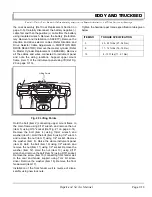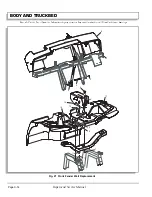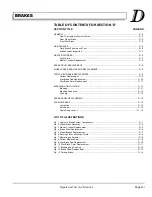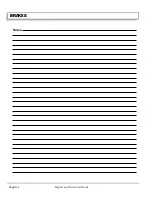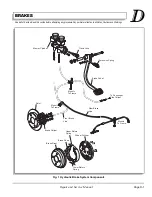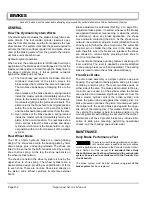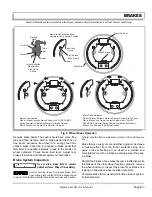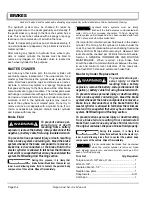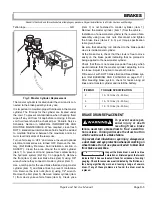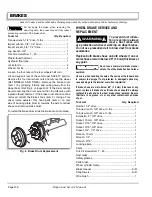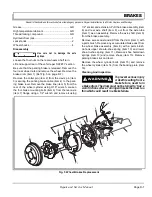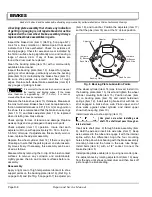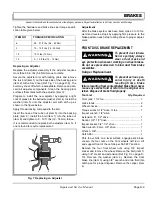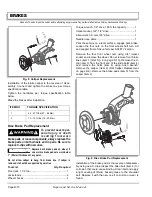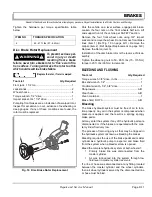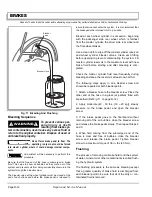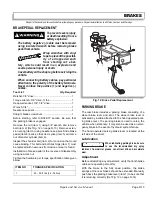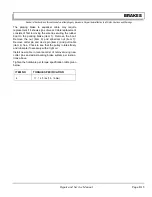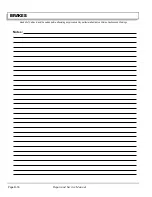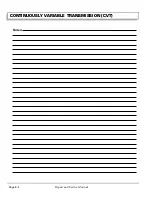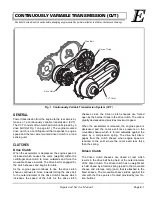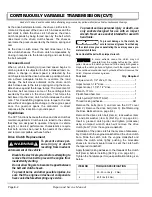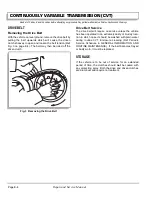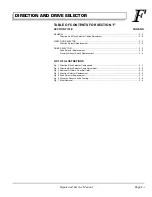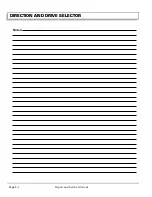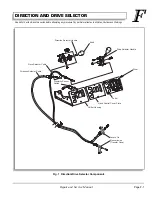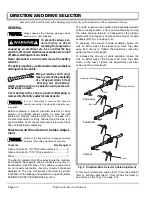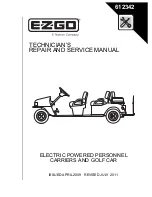
BRAKES
Page D-11
Repair and Service Manual
Read all of Section B and this section before attempting any procedure. Pay particular attention to all Notes, Cautions and Warnings
Tighten the hardware per torque specification table
below.
Disc Brake Rotor Replacement
To prevent serious per-
sona l injury or death
resulting from a brake
failure, never turn a brake rotor to ‘true’ a worn fric-
tion surface. Turning will make the rotor too thin
which could result in a brake failure.
Replace the rotor, if rotor is warped.
Tool List
Qty. Required
Floor jack, 1 1/2 ton .................................................... 1
Jack stands ................................................................. 2
Wheel chocks.............................................................. 4
Torque wrench, 1/2" drive ........................................... 1
Impact socket, 3/4", 1/2" drive..................................... 1
Pulsating front brakes are an indication of a warped rotor.
Inspect for excessive run out, evidence of overheating or
deep gouges. If any of these conditions are found, the
rotor must be replaced.
Park the vehicle on a level surface, engage park brake.
Loosen the four nuts on the front wheels half turn. Lift
and support front of the vehicle per SAFETY section.
Remove the four front wheel nuts using 3/4" impact
socket and remove the wheel. Do not remove front brake
lines (item 1) (Ref Fig. 10 on page D-11). Remove the
caliper (item 2) (Ref Caliper Replacement on page D-9).
Remove the Rotor (item 3).
Installation of the disc brake rotor is the reverse of disas-
sembly.
Tighten the wheel lug nuts to 50 - 85 ft. lbs (70 - 115 Nm)
torque in 20 ft. lbs (30 Nm) increments.
BLEEDING AND FLUSHING
Tool List
Qty. Required
Torque wrench, 3/8" drive, in. lbs. ............................... 1
Box end wrench, 1/4" .................................................. 1
Crowfoot wrench, 1/4", 3/8" drive ................................ 1
Shop towels............................................................. A/R
Clear hose ............................................................... A/R
Clean container ........................................................... 1
Brake fluid, DOT 3................................................... A/R
Bleeding
The brake hydraulic system must be free of air to func-
tion properly. Any air in the system is compressed when
pressure is applied, and the result is a springy, spongy
brake pedal.
Air may enter the system if any of the hydraulic parts are
disconnected or if the brakes are operated with the mas-
ter cylinder fluid very low.
The process of removing any air that may be trapped in
the hydraulic system is known as bleeding the brakes.
Bleeding requires the use of the brake pedal and master
cylinder as a hydraulic pump to expel air and brake fluid
from the system when a bleeder screw is opened.
Bleed the complete hydraulic system at both wheels if:
•
Primary brake line was disconnected from the
master cylinder.
•
Air was introduced into the system through low
fluid level in master cylinder reservoir.
If a line or hose was disconnected at any fitting located
between the master cylinder and the wheel cylinders,
then all wheel cylinders served by the disconnected line
or hose must be bled.
ITEM NO
TORQUE SPECIFICATION
4
42 -47 ft. lbs (57 - 64 Nm)
Fig. 10 Disc Brake Rotor Replacement
!
!
3
2
1
Summary of Contents for ST 4X4
Page 6: ...Page iv Repair and Service Manual TABLE OF CONTENTS Notes...
Page 10: ...Repair and Service Manual SAFETY INFORMATION Page viii Notes...
Page 12: ...GENERAL INFORMATION ROUTINE MAINTENANCE Page A ii Repair and Service Manual Notes...
Page 24: ...SAFETY Page B ii Repair and Service Manual Notes...
Page 34: ...BODY AND TRUCKBED Page C ii Repair and Service Manual Notes...
Page 50: ...BRAKES Page D ii Repair and Service Manual Notes...
Page 68: ...CONTINUOUSLY VARIABLE TRANSMISSION CVT Page E ii Repair and Service Manual Notes...
Page 74: ...DIRECTION AND DRIVE SELECTOR Page F ii Repair and Service Manual Notes...
Page 80: ...ELECTRICAL Page G ii Repair and Service Manual Notes...
Page 114: ...FRONT SUSPENSION AND STEERING Page J ii Repair and Service Manual Notes...
Page 128: ...FUEL SYSTEM Page K ii Repair and Service Manual Notes...
Page 136: ...PAINT Page L ii Repair and Service Manual Notes...
Page 142: ...REAR AXLE AND SUSPENSION Page M ii Repair and Service Manual Notes...
Page 152: ...SPEED CONTROL Page N ii Repair and Service Manual Notes...
Page 160: ...TROUBLESHOOTING Page P ii Repair and Service Manual Notes...
Page 168: ...WHEELS AND TIRES Page R ii Repair and Service Manual Notes...
Page 174: ...GENERAL SPECIFICATIONS Page S ii Repair and Service Manual Notes...
Page 180: ...LIMITED WARRANTY Page T ii Repair and Service Manual Notes...
Page 182: ...Page T 2 Repair and Service Manual LIMITED WARRANTY Notes...

